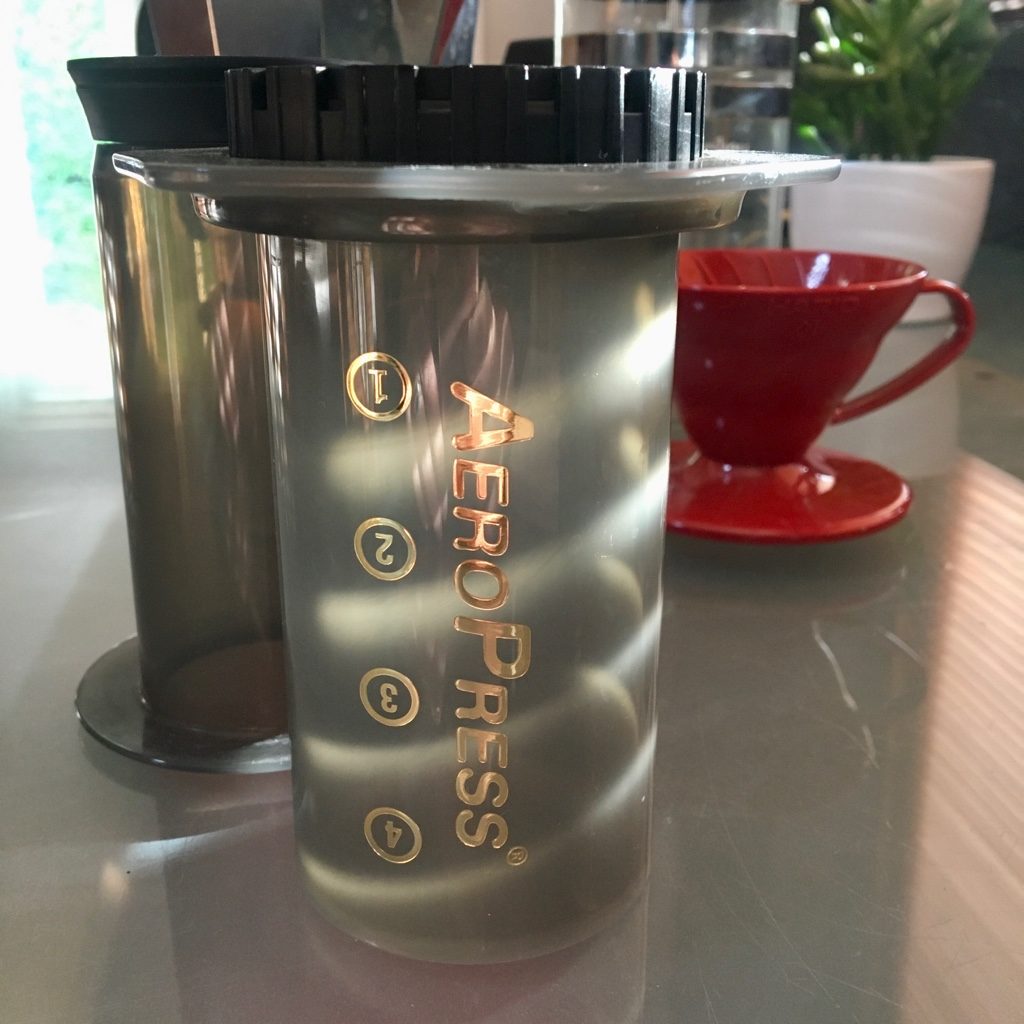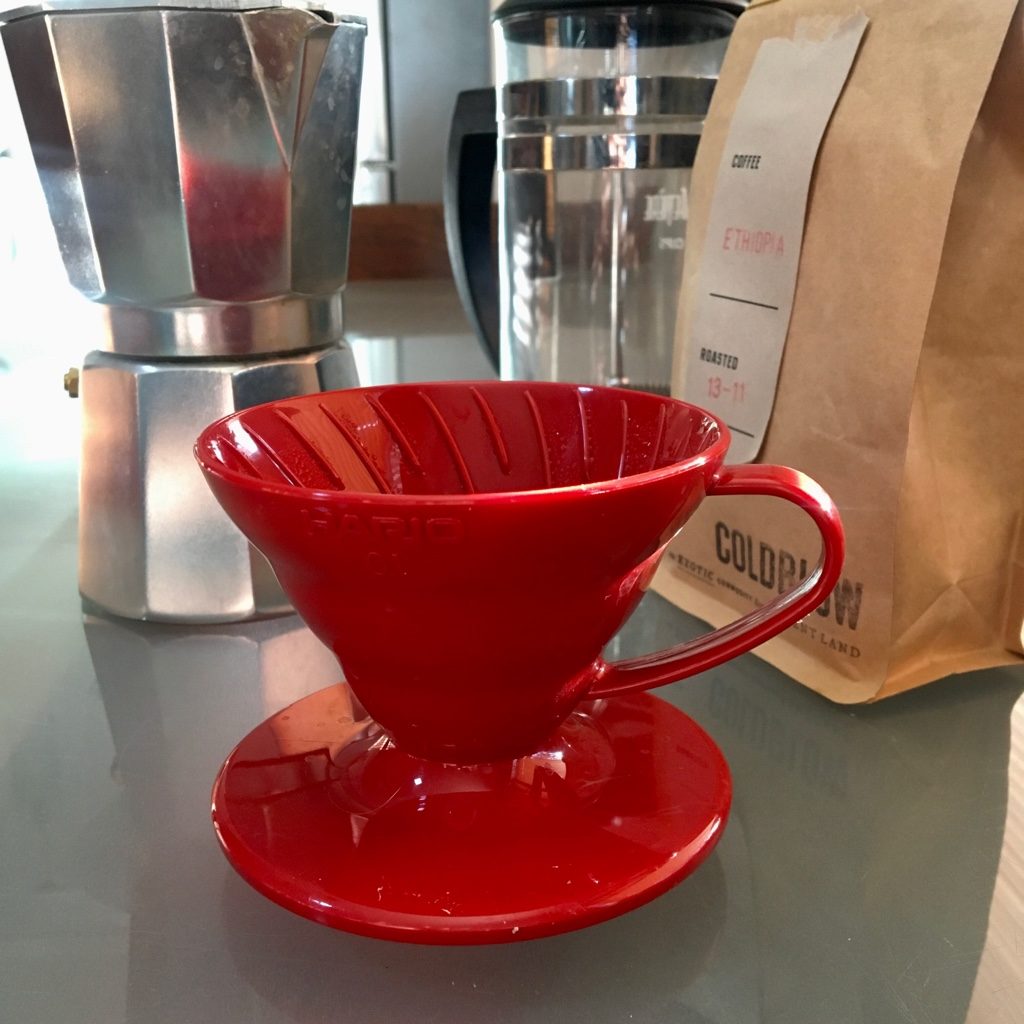Alternatives to espresso or capsule coffee machines
I’ve always been a bit of a devotee to espresso-based coffee. But if you don’t have a coffee machine at home or if you want a change from the short sour smack of the pressurised machine brewing methods, then there are some great alternatives to choose from. Some of them are fairly new and others are more traditional.
To test out some of these other options, my son Ollie and I decided we’d share an after-work coffee each day for four days. We’re both big coffee fans. Actually, he’s a full-on coffee geek and our kitchen resembles a coffee shop.
Armed with a bag of Coldblow Ethiopian Single Origin, we gathered in the kitchen each day to grind some beans and brew a cup or two: AeroPress, Moka Pot, Cafetiere and V60. For each, we’ve looked at the type of brewing, what that brings to the drink, how practical they are and which one we prefer. A chance to talk about coffee and about our day.
AeroPress
The AeroPress is the newest in terms of coffee innovation out of our four. It’s an immersion brewing method that relies on manual pressurised extraction. Which basically means that the coffee grounds are fully immersed and swished about a bit in the hot water in the brewing compartment. Then, once brewed, the coffee is forced through the filter paper using a plunger mechanism. This requires steady force over a sturdy cup or jug.
The resulting coffee is bright and sweet in flavour. It’s quite close to a filter coffee but produces a shorter drink. As the filter paper is very fine, it removes a lot of the oils from the coffee and therefore some of the bitterness from the flavour.
Other than flavour, some other benefits to this method are that it’s a compact system, it comes with a carry bag and filter papers so is a good option for travel, and it’s easy to clean out.

Moka Pot
The Moka Pot is a traditional evaporation brewing method that produces a more concentrated, richer coffee. It’s the closest of our four to espresso as it has a heavier mouthfeel and bitter flavour. What it doesn’t have is an espresso’s characteristic crema. Steamed milk would be a good addition to Moka Pot brewed coffee if you prefer a sweeter drink.
To brew, the pot is placed on the stovetop and as the water boils, it passes through the ground coffee. The metal separator between the top and bottom chambers holds the ground coffee and after the water has passed through, the coffee wells in the upper section of the pot.
Moka Pots or other similar stovetop coffee pots (this one below isn’t an actual Moka Pot) are simple to use. By design their restrictions on water to coffee ratio help with consistency. The only fiddly bit is cleaning out the used coffee grounds afterwards.

Cafetière or French Press
The cafetière is another immersion brewing method, but this one uses a metal gauze plunger to separate the coffee grounds from the liquid once it’s brewed. Cafetière coffee can be earthier, fuller-bodied and has more texture depending on the strength (how much coffee you use), but it can be powdery and may leave sediment at the bottom of the cup as the filter only removes the larger particles.
Overall, we found the flavour flatter than the other methods but the taste was stronger as it’s still quite bitter because the oils aren’t removed by the filter. The strength of coffee can be varied depending on the ratio of coffee to water, so it’s easy to make adjustments to your own taste.
Convenience is king with the cafetière. It’s a good option if you need to make more than one cup at once. The downside is that it can be messy to clean up and the plunger can easily slip during use and no one wants to drink bits of ground coffee.

V60
The V60 is a type of coffee dripper which works on the same principle as filter or percolator coffee, but on a smaller, simpler scale. It’s basically a one or two cup filter that sits on top of your cup or jug. It’s lined with a paper filter and the ground coffee goes in. Hot water is poured over and drips through.
The percolation through the filter produces a fine flavour and texture that tastes bright and clean. Although you can taste the acidity of the coffee clearly, it’s not bitter at all as again quite a bit of the oiliness is removed. The strength of brew can easily be adjusted by grind size and volume of water.
A key thing is to make sure you wet the filter paper first before putting in the coffee. And to then pour on just enough water for the coffee to ‘bloom’, before topping up the water. It still only takes about 3 minutes to brew a cup.

Conclusion: V60 is the favourite
The Hario V60 is the latest addition to our coffee gubbins at home and I think we’ve used it every day since.
I love the simplicity of its design and the ease of use.
Ollie prefers it because the clean taste allows the fruity flavour of the coffee to really come through. And despite what he’d say, you don’t need a gooseneck kettle to pour the perfect cup over a coffee dripper, our regular kettle seemed to do the job just fine.
“People didn’t know how to do that any more, brew some proper coffee. In the same way as nowadays nobody could write with a pen…..And where was the world going if people couldn’t even write or brew a bit of coffee?”
A Man Called Ove – Fredrik Backman
( 21 / #Write52 )
